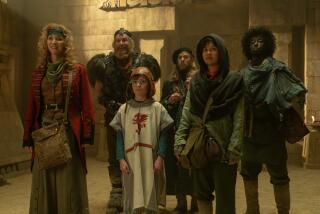‘Tut’ miniseries brings us fun with a pharaoh
Ben Kingsley is the selling point of “Tut,” Spike’s three-part miniseries about the pharaoh formerly known as Tutankhamen, which premieres Sunday. He is something to see, Sir Ben, with his shaven pate and Egyptian-drag eyeliner, peering through the undulating bodies of dancing girls with conniving menace.
Because, of course, there are dancing girls, and hot swordsmen stripped to the waist in the desert. There’s a scheming priest, a murderous general and a young queen wandering about in reproductive anxiety and sheer Egyptian frocks held together with a few amulets. There are orgies and exploited masses, rapist soldiers, super-big statues and pyramids shimmering in the heat.
Everything, in fact, that you’ve come to expect from a tale swaddled in the cradle of civilization except Liz Taylor in a fright wig or Anne Baxter moaning “Moses, Moses, Moses.” What is it about ancient Egypt that makes cinematic storytellers just lose their minds?
With his abundance of riches, both literal and narrative, King Tut is such a perfect subject for a miniseries that it’s hard to imagine what took them so long. What little is known about the boy king provides a checklist of epic-tragedy/cable drama.
He became king at age 9, had a coterie of advisors (no doubt scheming), married his half sister, with whom he could not produce an heir, and had, apparently, religious issues. When he died “mysteriously” at 19 (malaria is the most commonly cited cause), he was buried in golden glory beneath a faceplate that miraculously survived the centuries to make Tut one of the most instantly recognizable figures in history.
It’s fertile (crescent) ground for any writer, and, indeed, Michael Vickerman, Peter Paige and Bradley Bredeweg pull out all the stops.
So many, in fact, that you wish they’d shove a few back in.
Many historians believe that Tut’s imperfect skeleton made him unfit for battle, but the “Tut” writers make his ailments more metaphorical; Tut (Avan Jogia) is perceived as weak because he’s actually humane. The series opens with the prince as a child watching his father, who has been poisoned, order the torture and death of the poisoner, as well as his wife and child. The young Tut clearly does not have the stomach for such things, which his wily Grand Vizier Ay (Kingsley, of course) uses to his advantage.
In adulthood, Tut is just as gentle (and twice as pretty), allowing his buddy Ka (Peter Gadiot) to not only best him in swordplay but also make eyes at Queen Ankhe (Sibylla Deen). But behind Tut’s soulful gaze (lingered on to the point of absurdity) lurks the soul of a leader.
Like a certain Disney princess with similar identity issues, Tut slips out of the palace to learn about his kingdom and finds his spirit and a true friend. Who is neither genie nor street rat but the battle-toughened soldier Lagus (Iddo Goldberg).
Both spirit and friendship are put almost immediately to the test as Tut attempts to drive invaders from his land while wresting control from Gen. Horemheb (Nonso Anozie) and, of course, the vizier; Ay also has a son, a young man who seems to have wandered in from an ancient Egyptian version of “Gossip Girl.” Their scenes are, like the contents of Tut’s tomb, priceless.
To say more would spoil the fun, and there is fun to be had from “Tut,” which gallops from sex scene to battle scene to soulful close-up with remarkable rapidity. Kingsley may not be enjoying himself quite as much as he did in “Iron Man 3,” but the man could play a scheming grand vizier in his sleep, with or without the kohl — and Jogia does the best he can to humanize the man behind the world’s most famous mask.
Twitter: @marymacTV
------------
‘Tut’
Where: Spike
When: 9 p.m. Sunday though Tuesday
Rating: TV-14-LSV (may be unsuitable for children under the age of 14, with advisories for coarse language, sex and violence)
More to Read
The complete guide to home viewing
Get Screen Gab for everything about the TV shows and streaming movies everyone’s talking about.
You may occasionally receive promotional content from the Los Angeles Times.







